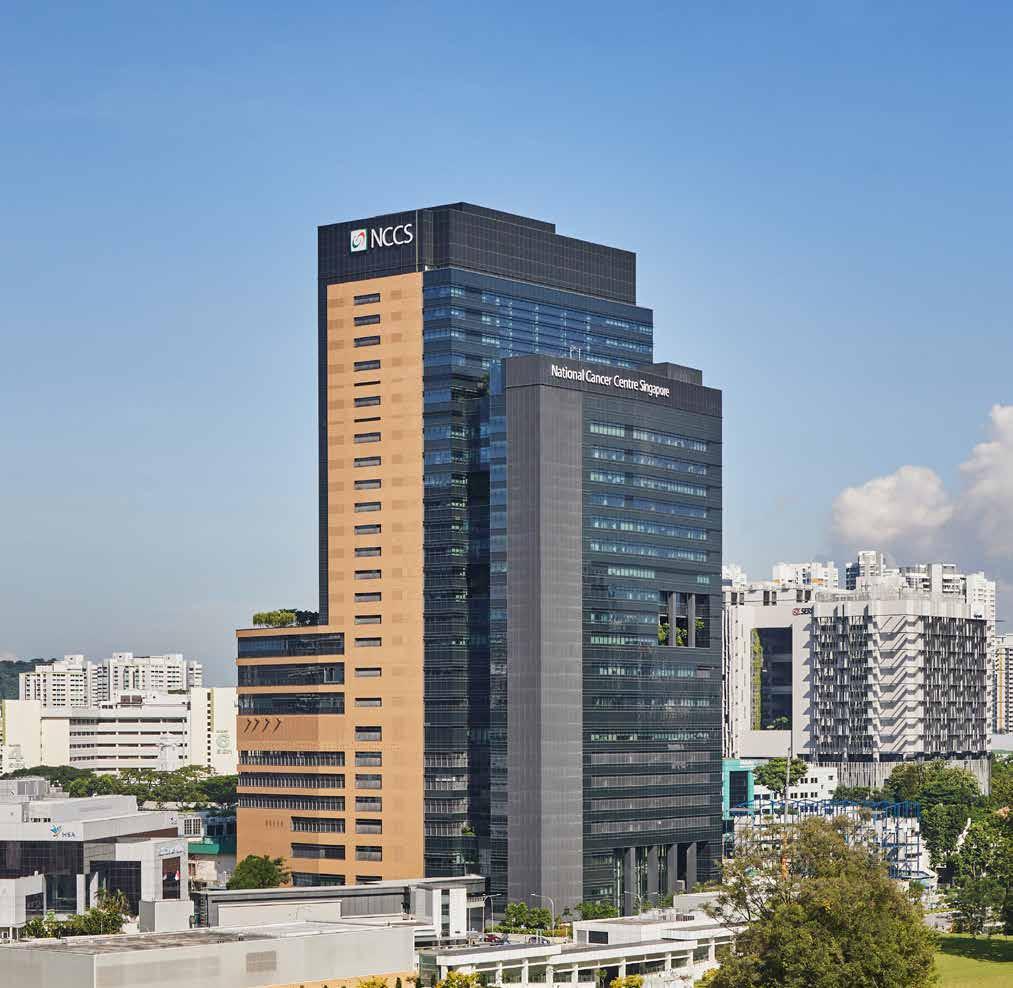
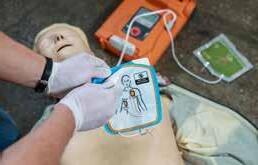
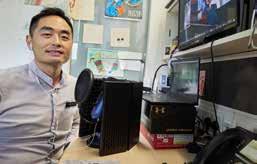


A look inside the new National Cancer Centre Singapore NCCS’ new home has innovative treatment and research facilities, and offers the full suite of cancer care THE FLAGSHIP PUBLICATION OF THE SINGHEALTH DUKE-NUS ACADEMIC MEDICAL CENTRE Jul-Aug 2023 www.sgh.com.sg www.singhealth.com.sg MCI (P) 002/07/2023 Receive latest updates via our free electronic mailer. Scan the QR code and subscribe now! 06 InFocus Improving survival rate of patients who suffer cardiac arrests 11 People SGH gastroenterologist’s podcasts hit far and wide 13 HealthWatch Recognise the signs of depression and get help Read more on page 02
PUBLISHERS
CO-PUBLISHERS
CONTENT ADVISORS
Audrey Lau, Jennifer Wee
EDITORIAL TEAM
Lim Mui Khi, Domenica Tan, Jenny Ang, Celine Sim
Read Singapore Health online at www.singhealth.com. sg/singaporehealth
PUBLISHING AGENT
ThinkFarm Pte Ltd


Managing Director
Christopher Tay
Head, Editorial
Chua Kim Beng
Head, Creative Lee Lily
Head, Client Relationship
Jessie Kek
For advertising enquiries, please call 6831 1299 or email advertise@thinkfarm.sg
A look inside the new National Cancer Centre Singapore
NCCS, Singapore’s national specialty centre for complex cancer care, has a spacious new home with innovative treatment and research facilities to meet future needs.
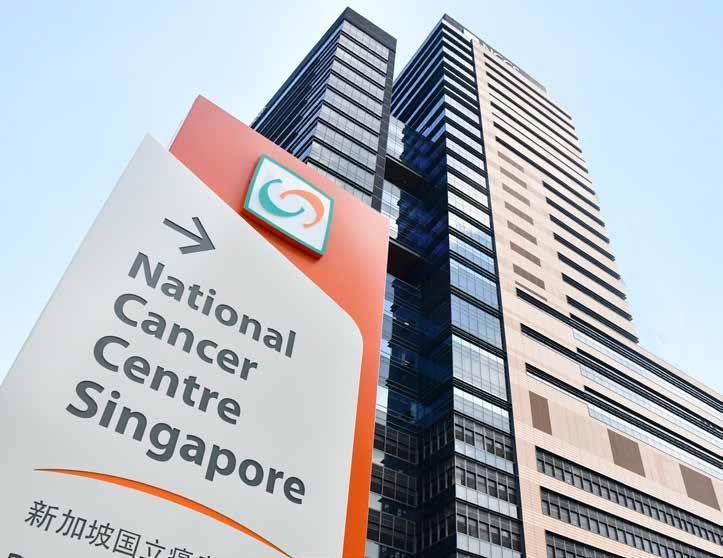 by Chua Kim Beng
by Chua Kim Beng
National Cancer Centre
All rights reserved. Copyright by Singapore Health Services Pte Ltd (registration no.: 200002698Z). Opinions expressed in Singapore Health are solely those of the writers and are not necessarily endorsed by SGH, SingHealth Group and/or Thinkfarm Pte Ltd (registration no.: 201226362G), and their related companies. They are not responsible or liable in any way for the contents of any of the advertisements, articles, photographs or illustrations contained in this publication. Editorial enquiries should be directed to the Editor, Singapore Health, 168 Jalan Bukit Merah, #13-01 Surbana One, Singapore 150168, or email: singaporehealth@singhealth.com.sg.
Unsolicited material will not be returned unless accompanied by a self-addressed envelope and sufficient return postage. While every reasonable care will be taken by the Editor, no responsibility is assumed for the return of unsolicited material.
ALL INFORMATION CORRECT AT TIME OF PRINTING. MCI (P) 002/07/2023. Printed in Singapore by Times Printers Pte Ltd (registration no.: 196700328H).
With 92,000 square metres of space spread over 24 storeys, the new NCCS building is about five times larger than its previous premises.
Singapore (NCCS) officially opened its new premises on 18 May 2023.
The new 24-storey centre has a total floor space of 92,000 square metres, which is about five times larger than its old premises. It has expanded capacity for care and treatment with 64 consultation rooms, 14 radiotherapy units and 108 recliner chairs and beds for chemotherapy — approximately double what the old building had. The three day-surgery operating theatres and two endoscopy suites now triple the space dedicated to diagnostic and surgical procedures.
Coping with the changing health landscape
Singapore is one of the fastest-ageing nations in the world; about one in four will be aged 65
or older by 2030. The average life expectancy here — 83.5 years — is among the highest in the world, but that also means a higher chance of cancers developing among the population. Between 2016 and 2020, nearly 81,000 new cancer cases were reported, and that number is expected to grow. As Singapore’s national specialty centre for complex cancer care, NCCS sees the majority of cancer cases in the public sector and offers the full suite of cancer care — from prevention, diagnosis and treatment to survivorship and palliative care. The move to the bigger, new centre was necessary to cope with the projected increase in cancer cases here.
Patient-centric design
In addition to expanded capacity, the new building is designed with the patient in mind. It is easily accessible by public transport and links directly to the Outram MRT station
02 CoverStory
®
via a covered bridge. Other patient services offered include home delivery of medications and home-care programmes. Technology is deployed throughout the building to enhance safety and efficiency — one example is the use of robots to deliver chemotherapy drugs to treatment suites.
Clinical, training and research facilities for each type of cancer are closely located to facilitate collaboration and improve convenience for patients. For example, a breast cancer patient can see the doctor, get a mammogram, receive financial counselling and get medications reviewed on the same floor. This also allows healthcare professionals to closely collaborate to improve care. “The integration and co-location of research and clinical services in the new NCCS will further boost collaborations and enable us to drive patient-informed scientific inquiry that leads to better patient outcomes,” said Professor Lim Soon Thye, Deputy Chief Executive Officer (Clinical), NCCS.
Programmes focused on adolescents and young adults, geriatric oncology, and young women with breast cancer take holistic care of patients in specific age brackets who have specific needs that require support.
Holistic integrated care
NCCS’ cancer care extends beyond the walls of the new building.
Patients have access to supportive and palliative care regardless of their stage of cancer, and are backed by cancer support groups, programmes and educational resources to achieve long-term quality of life.
To serve patients closer to their homes, NCCS runs satellite clinics in Changi General Hospital, Sengkang General Hospital and KK Women’s and Children’s Hospital.
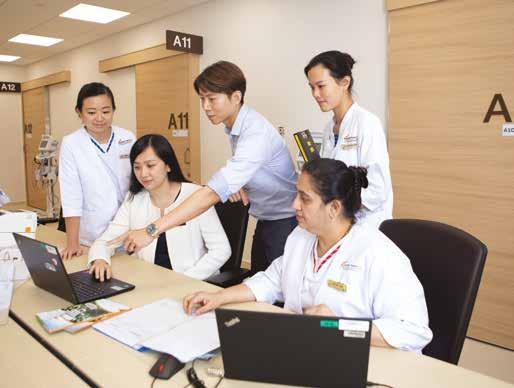
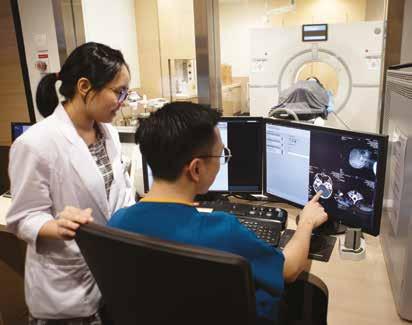
In line with the nation’s Healthier SG strategy, NCCS will continue to work with primary care and community partners to provide accessible care and rehabilitation. For example, the Singapore Cancer Society is housed in the new NCCS to extend public education and community outreach efforts to raise cancer awareness.
New and enhanced facilities at the NCCS building
l Goh Cheng Liang Proton Therapy Centre
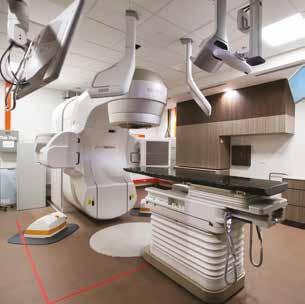
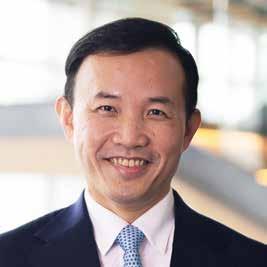
The Goh Cheng Liang Proton Therapy Centre, which is supported by a $50 million gift from the Goh Foundation, offers proton therapy, an advanced type of radiation therapy. The Centre has four treatment gantries where proton therapy is delivered to patients. Proton therapy is an advanced radiation treatment that precisely targets and destroys cancer cells while minimising damage to surrounding healthy tissues and causing fewer side effects.
l Ambulatory Treatment Unit
In the Ambulatory Treatment Unit (ATU), robots are used to deliver prepared chemotherapy drugs from the oncology pharmacy to treatment suites, freeing up nurses to spend more time attending to patients. There are 108 recliner chairs and beds for patients who receive treatment in the treatment suites. In addition to its core role of delivering chemotherapy, procedures such as bone marrow aspiration and lumbar puncture are also performed at the ATU.
l Multidisciplinary Hubs
On clinic floors, multidisciplinary hubs are where healthcare teams convene to plan personalised care for their patients. Located behind the 64 consultation rooms, the multidisciplinary hubs provide space for medical, radiation and surgical oncologists to discuss with each other on care plans. Consultations, scans, biopsies and treatments are all located nearby or on the same floor to make visits more convenient and comfortable for patients.
l Cancer Discovery Hub
The Cancer Discovery Hub (CDH) spearheads national-level initiatives on blood cancers, and supports biomarker discovery and clinical trials for breast and liver cancers. The CDH creates cell lines and 3D cancer models called organoids to facilitate high-impact research, and is also leading the setup of a national tumour organoid biobank. Assistant Professor Jason Chan, Director, CDH, cited a unique case, presented at a major cancer conference in the US earlier this year, of a pair of identical twins with a rare type of blood cancer treated at NCCS using advanced technologies at the CDH, such as single-cell sequencing and spatial profiling.
03 TO : SINGAP O R E P R E SS NIDLOH
Each cancer type has clinical, training and research facilities in close proximity.
Professor William Hwang Chief Executive Officer, National Cancer Centre Singapore
The new NCCS building is geared to meet future healthcare needs and provide affordable, accessible care to all Singaporeans. Our new centre is built around patients’ needs, with larger, improved facilities and innovative care programmes run by dedicated healthcare teams.
The most useful health app for all your needs!
APPOINTMENT
View and reschedule your appointments with ease!
PAYMENT
Pay anywhere, after consultation or treatment.



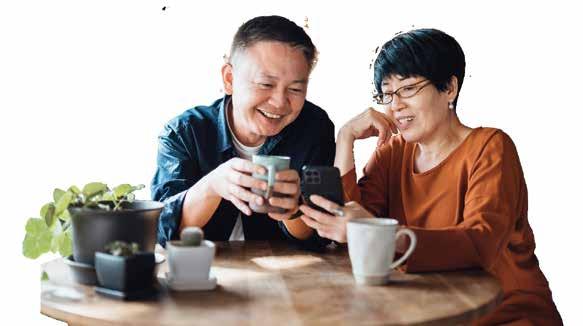
ORDER MEDICINE
Arrange for FREE delivery of your medicines!
TEST RESULTS & REPORTS


See all your test results here!
HEALTH TOOLS

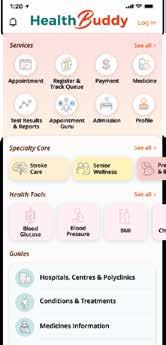
Track your blood glucose, blood pressure, weight and more!




Enhanced research capability
The new NCCS has almost 10,000 square metres of space dedicated to advance cancer research, where scientists and clinician-scientists can collaborate and innovate to improve treatment outcomes.
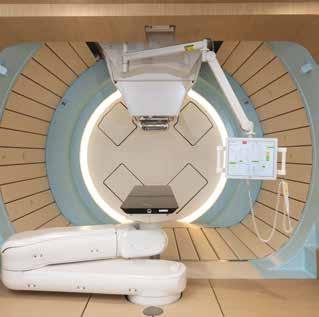
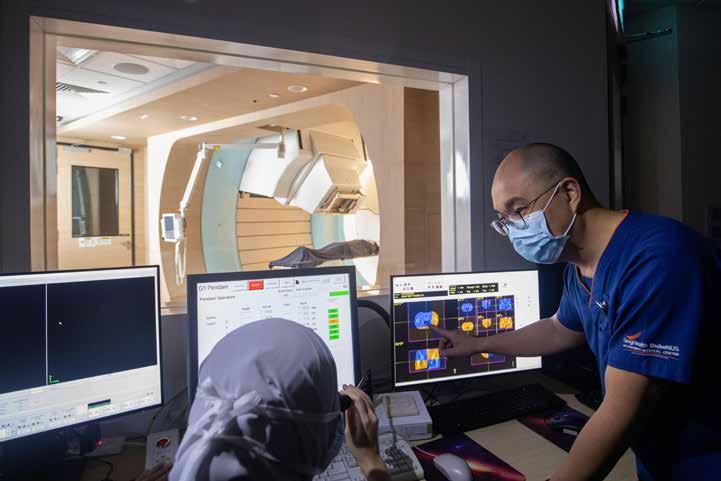
The building houses the Cancer Discovery Hub, where scientists use specialised services and novel technologies to uncover the mechanics and development of cancer, and enhanced capacity and capability to conduct clinical trials of new cancer therapies. There is also space for strategic partners, such as the Advanced Cell Therapy and Research Institute, Singapore (ACTRIS), which aims to facilitate the discovery, process development and manufacturing of cellular-based therapeutics.
The building is also home to the NCCS Tissue Bank — a satellite of the SingHealth Tissue Repository — which banks tissue samples from Asian cancer patients. This will enable researchers to gain a better understanding of cancer evolution in Asian patients.
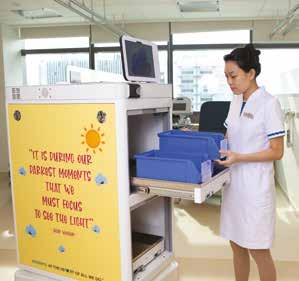
With operations at its new premises in full swing since March 2023, Professor William Hwang, Chief Executive Officer, NCCS, said, “The new NCCS building is geared to meet future healthcare needs and provide affordable, accessible care to all Singaporeans. Our new centre is built around patients’ needs, with larger, improved facilities and innovative care programmes run by dedicated healthcare teams. The ultimate goal is to provide holistic support every step of the cancer journey, so that NCCS serves as a beacon of hope for all our patients.”
Almost 10,000 square metres of space at the new NCCS is dedicated to advance cancer research.
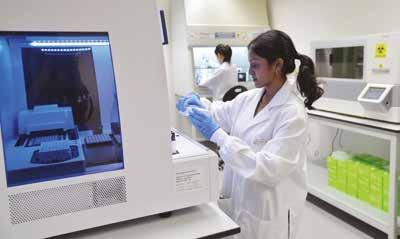
04 CoverStory
The new NCCS offers proton therapy, an advanced type of radiation treatment that precisely destroys cancer cells while minimising damage to surrounding healthy tissues.
Technology, such as the use of robots, is leveraged at the new NCCS.
PHOTO: SINGAPORE PRESS HOLDINGS
Scan to watch a video tour of the new NCCS building.
Treatment hope for lupus
Aprotein in blood may hold the key to treating systemic lupus erythematosus (SLE or lupus), an autoimmune disease that often causes a butterfly-shaped rash on the cheeks, a study by Singapore General Hospital (SGH) researchers has found.
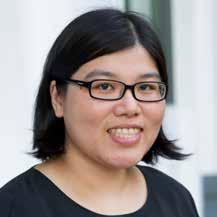
The CXCL5 protein, which is naturally secreted in the human body, helps to regulate the immune system through neutrophils, a type of white blood cell. The immune system normally protects people against infections; however, in SLE patients, the immune system turns against itself and attacks the body’s healthy tissues and organs, causing widespread inflammation. “In SLE patients with active disease, we found that serum CXCL5 levels were significantly lower than in healthy individuals and were negatively correlated with disease activity,” said Dr Annie Law, Senior Consultant, Department of Rheumatology and Immunology, Singapore General Hospital (SGH).
The study also found that restoring the level of the protein in mice improved survival. The team found that injecting mice with severe lupus weekly with CXCL5 restored balance, and improved survival from 25 per cent to over 70 per cent at 10 weeks. This number cannot be extrapolated to humans.
Furthermore, when CXCL5 was given together with cyclophosphamide (a conventional potent immunosuppressive treatment for lupus), CXCL5 seemed
Goh
to prevent the toxic effects of cyclophosphamide, enabling the mice to survive up to two years. CXCL5 can be administered directly into the bloodstream via a vein or under the skin.
“Our study has shown CXCL5 to be safe. There was no liver or kidney toxicity, or cancer-inducing effects. Major components of the immune system were also not compromised. We hope to take our findings further to improve the care of patients with lupus,” said Dr Fan Xiubo, Principal Investigator and Senior Research Fellow, Department of Clinical Translational Research, SGH.
The team hopes to use the treatment in patients with moderate lupus, including those with lupus nephritis, where the kidneys are damaged by lupus.
The prevalence of lupus worldwide ranges from 37 to 100 per 100,000, compared to 40 to 150 per 100,000 in Asians, Dr Law said. The disease tends to affect Asians more severely. Both men and women can get the illness, with more women of reproductive age diagnosed with lupus.
As lupus has no cure, steroids, antimalarial drugs and immunosuppressants are used to control the condition. However, 30 to 60 per cent of patients do not respond to the aggressive drug regimens, said study senior author, Associate Professor Andrea Low, Senior Consultant and Head, Department of Rheumatology and Immunology, SGH. The US’ Food and Drug Administration has approved just three new lupus drugs — with modest efficacy — in the
past 65 years. “There is therefore a real and urgent need for better therapies, particularly for the more severe spectrum of lupus that we see in Asia,” said Assoc Prof Low.


Professor William Hwang, Senior Consultant, Department of Haematology, SGH, who co-led the early phases of the study, added, “It is gratifying to see that this research, which started over eight years ago, has led to a discovery that has the potential to offer patients with lupus new treatment options in future.” Prof Hwang is also Chief Executive Officer of the National Cancer Centre Singapore. The study findings were published in October 2022 in one of the top peerreviewed rheumatology journals, Arthritis and Rheumatology, and were highlighted as an important study in Nature Reviews Rheumatology in November 2022. Patent covering these results was filed by SingHealth, and has since been granted in the US and Singapore.
The research team expects to enter Phase I and Phase II clinical trials in the next three years.
In an SGH study on mice with lupus, injecting the CXCL5 protein into them seemed to improve their condition, says Dr Fan Xiubo.
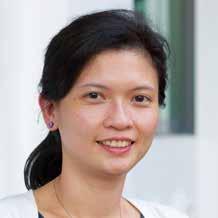
05 InFocus
Low levels of a protein in blood suggest reason for lupus activity and restoration to normal levels holds promise of treatment, SGH study finds.
by
Bee Lian
(From left to right)
Assoc Prof Andrea Low, Prof William Hwang and Dr Annie Law.
Keeping hearts beating
by Elena Owyong
More individuals are suffering from cardiac arrests in Singapore. However, with the concerted efforts of SingHealth and other agencies, the survival rates have improved from 2 to 25 per cent.
More than 3,000 cardiac arrests happen outside of hospitals in Singapore annually. Termed ‘out-of-hospital cardiac arrest’ (OHCA) cases, this figure is expected to rise, said Professor Marcus Ong, Senior Consultant, Department of Emergency Medicine, Singapore General Hospital (SGH). Prof Ong is concurrently the chairman of the Pan Asian Resuscitation Outcomes Study (PAROS) network, which conducts pre-hospital and emergency care (PEC) research and encourages collaboration within the industry to improve PEC.
“There are several possible factors driving the increase in OHCA locally. We have a rapidly ageing population.
a bystander — a relative or a member of the public — nearby.
“The PEC system can be described using the ‘chain of survival’ concept. The chain of survival is a series of interconnected links that all need to be working well for someone to survive a cardiac arrest,” Prof Ong shared. There are three key elements to the chain of survival: community, dispatch and hospital. The community can help to recognise cardiac arrest early, provide CPR and use an AED to help the patient, while dispatch entails the early activation of the 995 system so that the Singapore Civil Defence Force (SCDF) can send the appropriate help for early advanced care and, lastly, the hospital that provides post-resuscitation care.
app that will enable video-coaching by a dispatcher,” he said.
Beyond that, there are also plans for a trial to equip volunteers with nextgeneration AEDs, which are lighter and more compact. Advanced treatments by firefighters and ambulance crews will also continue to evolve.
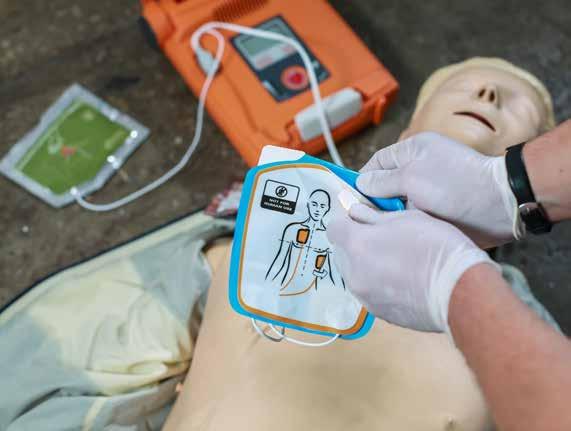
Pre-Hospital Emergency Care Programme in Southeast Asia (PEC)
“There are several possible factors driving the increase in OHCA locally,” says Prof Ong.

The burden of chronic disease — such as hypertension, diabetes and heart disease that predisposes one to sudden cardiac death — is still increasing. We are also doing a better job of capturing data on such events,” Prof Ong explained. This trend is consistent with what is being seen in developing countries. However, in some advanced economies, the number of OHCA has been stable or even declining, in tandem with a decrease in risk factors for heart disease (smoking, hypertension, diabetes, etc).
When it comes to improving the survival rates of OHCA cases, every minute counts. If a bystander administers cardiopulmonary resuscitation (CPR) or uses an automated external defibrillator (AED) immediately, it can increase the patient’s chances of survival by 50 per cent. Prof Ong explained that help from the community in saving lives forms a crucial part of the PEC system, since 70 to 80 per cent of OHCA cases occur in the home or public places where there is often
Prof Ong noted that, in the last 10 years, Singapore has made tremendous progress in the survival rates of OHCA cases. Community interventions increase bystander CPR and defibrillation before ambulance arrival that can increase survival rates several fold. “Initiatives such as CPR training in schools, during national service and through the DARE (Dispatcher-Assisted First Responder) programme, dispatcher-assisted CPR and the MyResponder application have allowed Singapore’s bystander CPR rates to increase from 20 per cent to more than 50 per cent today. We are also seeing a fivefold increase in the use of AEDs through the Save-A-Life (SAL) programme and mapping of public AEDs.”
Advanced treatments by firefighters and ambulance crews (high-performance CPR, devices to deliver drugs, open the airway, and mechanical CPR) and at the hospital (cooling to protect vital organs, opening blocked arteries, heart-lung bypass) mean that more than 70 per cent of survivors have good brain function on discharge.
To further increase the survival rates of OHCA patients, Prof Ong revealed that SingHealth has several ongoing research initiatives for the next five years. “We will introduce to our community volunteers on MyResponder new interventions like TCPRLINK, which will equip them with a credit card-sized CPR feedback device and a phone
In May 2022, SingHealth and Temasek Foundation launched the Pre-Hospital Emergency Care Programme in Southeast Asia (PEC) to improve survival and outcomes for patients with medical emergencies. The programme was developed in collaboration with the Asian Association for Emergency Medical Services (AAEMS) and the Pan Asian Resuscitation Outcomes Study (PAROS) network.
The three-year ground-up programme aims to train 250 participants from Indonesia, Malaysia, Vietnam, Thailand and the Philippines on emergency skills required to recognise, intervene and treat pre-hospital emergency cases. The participants include healthcare officials and workers, ambulance personnel, emergency first responders as well as leaders of community organisations. Of these participants, 30 will also be equipped to be Master Trainers; they will help to enhance the PEC systems in their respective countries and train other professionals and community partners.
The first run of the programme, with 30 participants, was completed in November 2022. A second run was held with the Master Trainers in February 2023.
06 InFocus
As out-of-hospital cardiac arrest cases in Singapore rise, SingHealth shares plans to improve the survival rates of these patients.
Brain Power
Taking care of our brain will help to improve our work efficiency and mental sharpness.
Staying active with sufficient brain-boosting nutrients in our diet will help to preserve good memory experience for a better quality of life as we age.
Sharp•PS™ Sharp Memory Brain Boosting Benefits
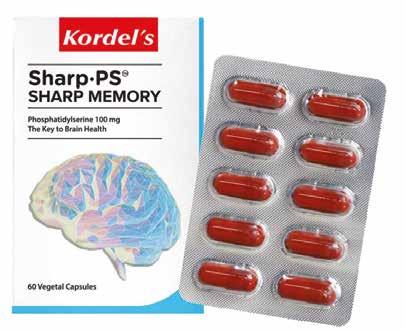
Mental Sharpness
Supports the formation of neurons
Good Brain Health
Covers and protects the cells in our brain and strengthens the brain structure

Memory and Sharp Thinking
Improves short-term memory and enhances the ability to retrieve, learn and recall for long term memory
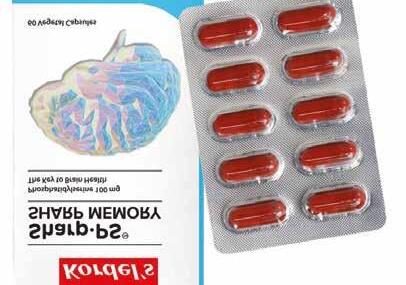

Visit www.kordels.com.sg for more information
Catering for thousands thrice a day
Singapore General Hospital has a new kitchen, where an army of robots and other machines work alongside staff to produce and deliver thousands of nutritious meals each day to support the recovery of inpatients.
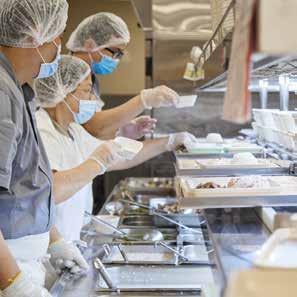
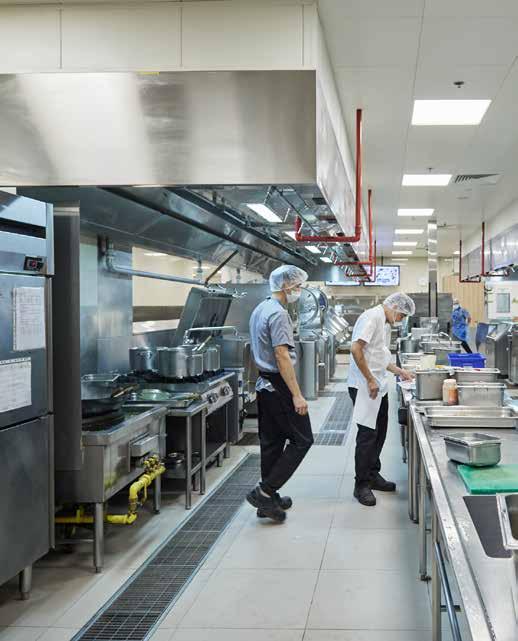 by Goh Bee Lian
by Goh Bee Lian
It moves surreptitiously. Like the cockroach — after which the robot is nicknamed — it is able to quietly squeeze through tiny places and withstand loads many hundred times its own body weight.
Indeed, this automated guided vehicle, one of a team used at Singapore General Hospital’s (SGH) kitchen, dips under meal trolleys, weighing some 200 kilogrammes, lifts and transports them from the kitchen to the wards.

The vehicle, giant pots that stir food automatically and newly designed food trolleys are among a slew of new equipment employed by SGH’s Food Services Department when it moved to its spanking new home in SingHealth Tower. The kitchen used to be housed in the cramped SGH Block 8. The move gave the department a chance to refresh its processes and procedures. “This is especially important as the kitchen will be serving many more patients when the new Emergency Medicine Building and Elective Care Centre are ready in coming years,” said Ms Eileen Lim, Senior Manager, Food Services Department, SGH.
The new kitchen currently prepares some 2,000 meals three times a day — breakfast, lunch and dinner — but can be expected to add another 300 to 500 meals when new buildings within the SGH Campus are up and running. It is a tall order even with a crew of 89, who deal with everything from designing menus to preparing food. Another 36 external staff clean the kitchen after meals, including used crockery. Having equipment that does the heavy lifting goes
a long way towards helping staff.
Without the automated vehicle, for instance, staff must push the heavy food-laden trolleys themselves, hook them onto a trolley truck, which is then driven through the hospital’s underground tunnels to the wards at the main SGH blocks. Like cement mixers, the pots allow chefs to cook huge vats of vegetable or to fry rice without having to do the stirring or tossing, said Mr Tan Loon Liang, Senior Executive Chef, Food Services Department, SGH.
The trolleys, too, have been redesigned, after feedback from ward nurses. The new trolleys have compartments to keep food hot and cold separately, so there is no need to take the cold food out when reheating the hot food at the ward. The food tray has also been redesigned to be slotted into the trolley compartments. Ward nurses just need to plug in the trolley and take the trays out for serving.
With the larger space, the kitchen is laid out with a streamlined workflow so that cooked and raw food do not come into contact. Cook-chill dishes that are cooked to be served in the following days are moved into the blast-chillers to be chilled down immediately after cooking is complete, followed by storage into
08 InFocus
We serve five major categories of meals: Chinese, Chinese vegetarian, Indian Muslim, Indian vegetarian and Western. Within each category, we break it down further — full diet, soft diet — which has different selections for the Chinese, Indian Muslim and Western categories. Our menu range is very wide.
Ms Eileen Lim Senior Manager, Food Services Department, Singapore General Hospital
The ‘cockroach’ is programmed to lift the trolleys and take them to the wards.
The human touch is still necessary even though machines have taken over some tasks like washing rice and cooking large amounts of vegetables or noodles in giant pots.

food banks. On the day of serving, the dishes are placed in special ovens at the correct temperature before serving. In the old smaller kitchen, the chiller was situated behind the cooking area. So cooked food was taken to the back, then when it was ready for use, staff had to go past the preparation and cooking sections again to retrieve the food from the chiller. “In the new kitchen, the cooking process moves in a single direction, every step is forward-going. There is no backtracking, which is not ideal for food safety,” said Mr Tan.
NUMBERS
2,000 number of MEALS per mealtime
prepared each mealtime
2,700potential number of MEALS per mealtime 2,700 MEALS
3 (breakfast, lunch, dinner) each day number of MEALS
kitchen working hours 5am–10pm
“In the new kitchen, the cooking process moves in a single direction. There is no backtracking, which is not ideal for food safety,” says Mr Tan Loon Liang. Ms Eileen Lim adds that the new kitchen is so big that “staff even got lost”.
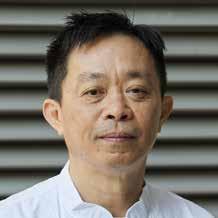
The move in August 2020 was made seamlessly after many simulation sessions to familiarise staff with the new equipment and layout. “There is more walking because the kitchen is so big, and staff even got lost! We underwent a few rounds of training to make sure that they can handle the new equipment and machines safely. We also had two rounds of full-dress rehearsal before we shifted over to prep our people on what will happen on the day of the shift itself,” said Ms Lim.
The kitchen staff, in their 20s to 60s, have adapted well to the new processes and their new mechanical workmates.
To help staff cope with the move, the department kept the menu unchanged for more than three years instead of the usual two years. A simplified menu was also used during the time straddling the shift, but the department has since settled back into its old routine, where menus are rotated fortnightly.
When patients get hungry at night
Dinner orders end at 4.45pm, but a standard late meal can still be ordered till 7pm.
The late meals will be sent to the hospital’s satellite pantry and dispatched to the respective wards. No meals are served after 8pm. However, patients feeling peckish after the meal service for the day ends can ask ward nurses for snacks of biscuits and warm beverages.
Greening of the kitchen
SGH offers its patients five types of meals — Chinese, Chinese vegetarian, Indian Muslim, Indian vegetarian, Western — that include a soft version for each. The chefs and dietitians sit down once every two years to plan a new overall menu. The kitchen is also able to cook special and therapeutic meals according to SGH dietitians’ orders.
Besides supervising the smooth running of the daily operations, the department’s executive chefs research new dishes, organise food tastings and follow up on patient feedback about the meals. On special occasions, festive touches are added to the menu to enhance the celebratory mood. Much thought goes into the tiniest of details. For the SGH Bicentennial in 2021, the kitchen baked 1,800 soft cranberry biscuits that were served to all inpatients on 4 January, the first working day of the year.
The Food Services Department is collaborating with Environmental Services to recycle raw kitchen wastes like vegetable scraps, apple cores and over-ripe bananas for vermicomposting. Earthworms and other microorganisms break down the food wastes into compost, which is then used as organic fertiliser for SGH Campus’s gardens.
Unconsumed food is thrown away for safety reasons, but the Food Services Department is looking into the use of recycling processors like biodigesters.
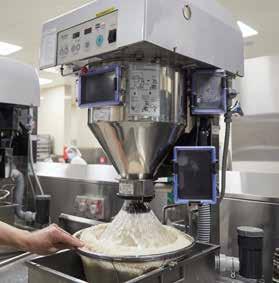
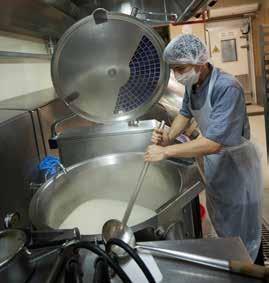
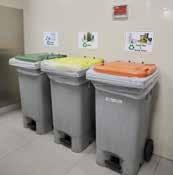
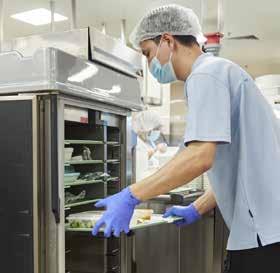
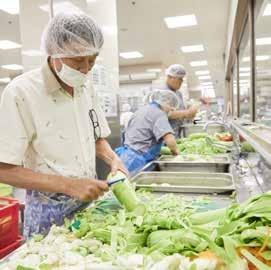
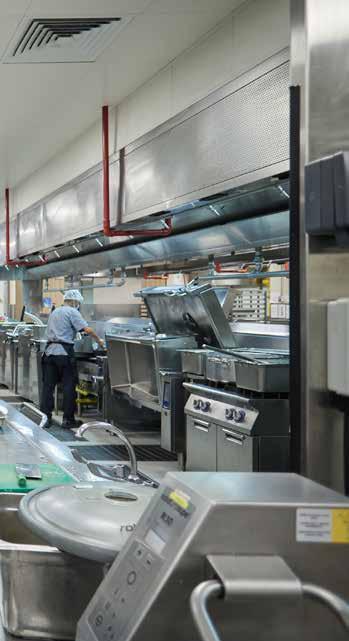
09
PHOTOS: VERNON WONG
OUTSOURCED
kitchen
it
6pm–10pm
CONTRACTORS clean the
and get
ready for the next day
4,500 size of new kitchen SQUARE METRES
Taking a stab at home risks
by Vicki Yang
touch his friends’ lives. “He played a song on the keyboard for me and I played a short tune for him. After this, he was encouraged to write more songs. It made me reflect on how much my work can help residents in small, intangible ways like sharing our mutual love of music,” said Mr Goh.
Mr Goh also leads the Temasek Foundation Parkinson’s disease programme as he had previously worked with inpatients with neurological conditions. “Under the programme, Parkinson’s disease patients learn to handle their symptoms to live safely and comfortably at home, including reducing their risks of falling,” he explained.
Mr Goh’s expansive career has found parallels in a favoured hobby — competitive fencing, a sport in which he has won a bronze in the foil category.
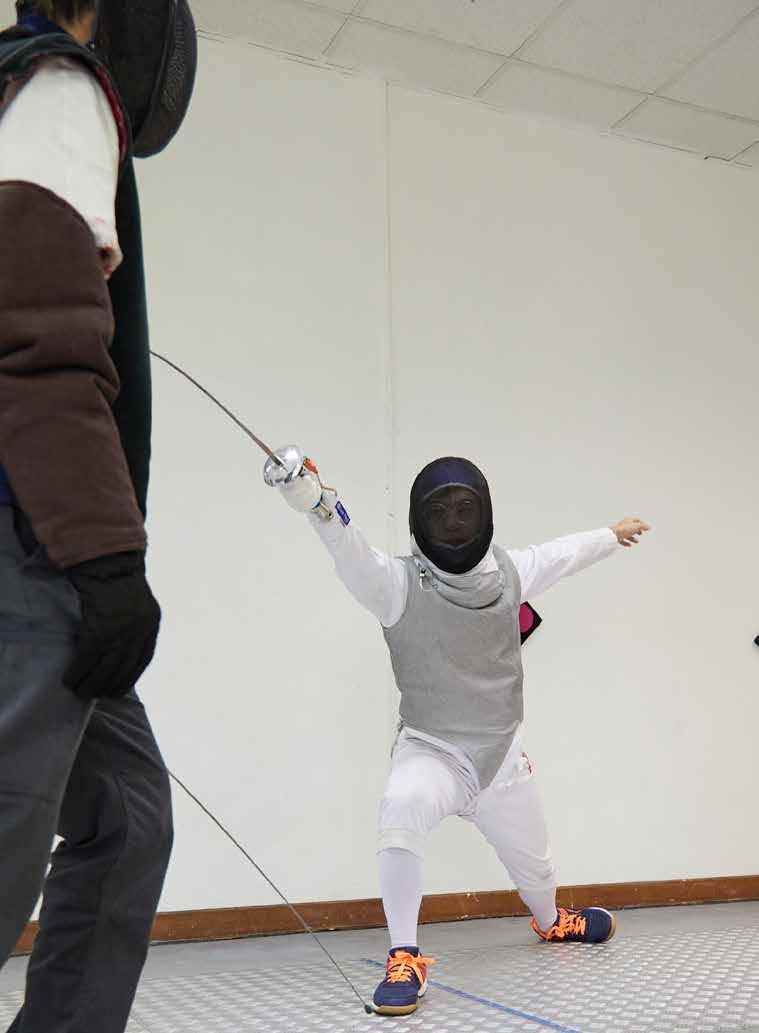
Just as an opponent can quickly lunge at him, a resident can suddenly face multiple medical issues. “Fencing has trained me to define my priorities clearly in my daily work, where I must collate information, decide which issue to resolve first, then explain the reasoning behind these decisions to the resident,” said Mr Goh.
The joy of partaking in fencing and making music resonates with Mr Goh’s future vision as well as that of those he serves. “To me, community nursing means empowering the community to manage their health and giving them care and concern so they can lead fulfilling lives with positive attitudes that touch others in the community,” said Mr Goh.
Aslanted ray of sunlight falling across a room, a flask positioned on an edge, a disjointed floor tile — the minutiae of daily life may seem minor and unimportant, but reveal a world of information about a patient’s needs to a community nurse like Mr Goh Rui Hao.
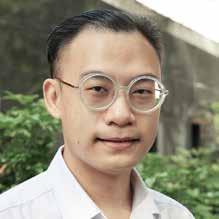
Looking out for such seeming trivialities at home is important as they can lead to falls and injury; attending to them ensures a safe and accident-free living at home. These are things that nurses and other healthcare staff stationed in hospitals are not able to do.
“When I was working in the inpatient wards, I saw how much my colleagues and I were doing for patients. But I also wondered how the patients would be able to cope when they are discharged. Things happen on the ground, at home or in the community, so how will they cope on their own when they
age and their conditions advance?” asked Mr Goh, Senior Staff Nurse (Community Nurse), PHICO-Community Nursing, Singapore General Hospital (SGH). “In the community setting, I can observe how patients’ actions impact daily life, like walking or showering. I can see if sunlight shining through a window affects sleep, or if they have strong home support.
A turning point came during the COVID-19 pandemic, when Mr Goh was assigned to dormitories housing migrant workers. “Many of them were unaware of public health issues, and became distressed when they caught COVID. This triggered a desire to go into community nursing to broaden my perspectives in healthcare,” Mr Goh added.
Mr Goh feels privileged to “enter” patients’ personal lives when he sees them at home. He remembers a cancer patient who, despite being in pain, confided in Mr Goh how he wanted to make music at church and
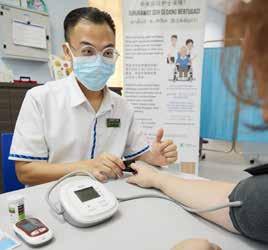
PHOTOS: VERNON WONG
Beyond the hospital walls lies a transformative world of community healthcare, where patients learn to manage their health and live life to the full in the place they call home.
Goh Rui Hao
Senior Staff Nurse (Community Nurse), PHICO-Community Nursing, Singapore General Hospital
To me, community nursing means empowering the community to manage their health and giving them care and concern so they can lead fulfilling lives.
From geek to podcasting influencer
The team produces their podcasts wherever they can find the space, and makes do with equipment that they find online. Dr Andrew
He sometimes records his podcasts from his child’s bedroom. But the words from his Guts & Glory channel have gone around the world to reach the ears of medical professionals in respected healthcare institutions like Mayo Clinic and Johns Hopkins Hospital in the US. For Dr Andrew Ong, the podcasts he created to help his students during the COVID-19 pandemic have succeeded beyond his initial expectations.
“Our podcast listeners are only a third Singaporeans. I think that one of the great success stories of our podcast is how far it has reached listeners around the world. It wasn’t easy, a lot of work had to happen to get there,” said Dr Ong, Consultant, Department of Gastroenterology and Hepatology, Singapore General Hospital (SGH).
The seeds of podcasting were sown early. A self-confessed podcast geek, Dr Ong listens to all kinds of podcasts while driving, walking and doing other things. “It makes my commute more informative. At the end of a drive, I can say I’ve learned something, I didn’t waste time as I drove,” he said.
Dr Ong toyed with the idea of starting a podcast after he had been writing a weekly blog for his students for two years. So when he was approached by Dr Dillon Yeo, Resident, SingHealth, to start one, the answer was an easy “yes”. Another SingHealth Resident, Dr Toh Ching Han, made up the third member of the venture.
As the seasoned gastroenterologist, Dr Ong was content expert, researching topics, choosing “good” questions to stimulate discussion, while Drs Yeo and Toh worked on infographics and post-production processing. “We also had to be very aggressive in disseminating the information,” said Dr Ong, who added that posting on platforms such as Twitter and LinkedIn added traction in reaching a wider audience.
The channel began in mid-2021, built purely on their interests in podcasting and their impulse to ensure medical students continue learning after lessons were cancelled due to the pandemic. “We wanted to deliver a product primarily to medical students, so for every episode, we prepared
show notes, references and infographics. We wanted listeners to be able to follow our conversation and have a product to take back to study and learn,” he said.
That modest aspiration was quickly exceeded as their channel found fans among postgraduates, non-doctors and even patients. With the power of the Internet, Guts & Glory’s audience has expanded beyond Singapore — 37 per cent of listeners are from Singapore, 34 per cent from the US and the rest from Australia, the UK, Malaysia, Hong Kong, the Philippines and elsewhere. Downloads average 600 per episode, with some episodes reaching as high as 1,500; total downloads is estimated at more than 15,000. LinkedIn posts on the podcasts were viewed around 3,000 times per post on average.
Sound quality, podcast venue and time were some of the early problems the trio faced. Another was continuity. From his blogging experience, Dr Ong knew that they would lose listeners if one of them took a break and they stopped broadcasting for a few weeks. “Listeners feel the emptiness when the person posting suddenly goes on leave,” he said. To avoid this, they built up a bank of episodes by recording episodes backto-back or more frequently.
As a sub-specialist in functional gastrointestinal disorders, Dr Ong unsurprisingly devoted the first season to gastroenterology-related content. The team has since included guests from SGH’s endocrinology, infectious diseases, oncology and respiratory medicine departments, and even from the National University Hospital.
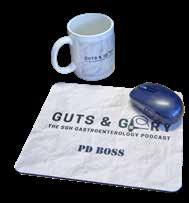
After 30 episodes, the team wants colleagues to come on board the channel. “People are willing to participate (as guests) but not to drive the channel when they hear about postproduction processing and dissemination,” said Dr Ong, pointing to staff’s tight schedules and funding issues as other reasons.
Perhaps one way to lure others is the fame associated with a successful podcast channel. Said Dr Ong, “My daughter told her friends she has the coolest dad because he’s on Spotify. That was an additional bonus because suddenly I’m an influencer! I’m a podcaster!”
Just as podcasting has its issues to overcome, the work that Dr Ong does as
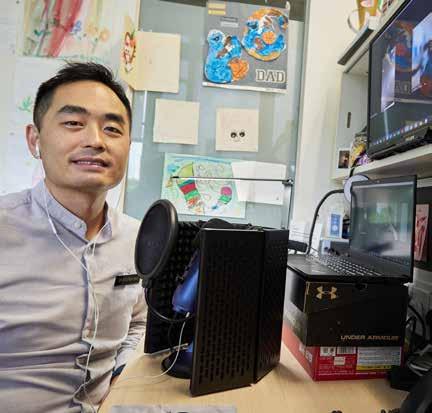
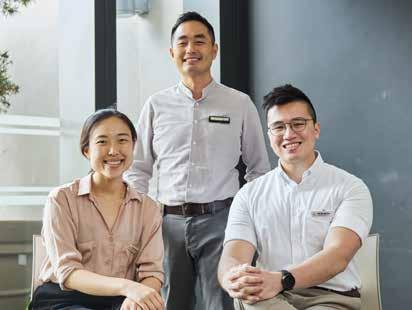
a doctor has its challenges too. He sees patients mostly with common conditions like irritable bowel syndrome and gastroesophageal reflux, but some have issues that are not easily diagnosed. “You end up walking the journey with them because you want to help them as much as you can to improve their quality of life,” he said.
As a gastroenterologist, Dr Ong is often the most popular guest during Chinese New Year visits. “I am often asked about common stomach symptoms, what foods to avoid and so on,” he said good-humouredly.
11 People
PHOTOS: VERNON WONG
Dr Toh Ching Han and Dr Dillon Yeo (both seated) work on post-production and infographics of their podcast, while Dr Andrew Ong focuses on content and research.
Dr Andrew Ong began podcasting gastrorelated content to help his students during the COVID-19 pandemic, but his channel has succeeded beyond that modest aspiration.
by Goh Bee Lian
Dr Andrew Ong Consultant, Department of Gastroenterology and Hepatology, Singapore General Hospital
Our podcast listeners are only a third Singaporeans. I think that one of the great success stories of our podcast is how far it has reached listeners around the world. It wasn’t easy, a lot of work had to happen to get there.
Ong places a tiny screen around the microphone to reduce ambient noise and echo in his office.
Keeping liver diseases at bay
by Vicki Yang, with
Clinical Assistant Professor Eugene Wong, Consultant, Department of Gastroenterology and Hepatology, Changi General Hospital
What the liver does
Produces bile for digestion and breaks down fats into energy
Makes important physiological products such as cholesterol for the body
Processes and stores essential nutrients that we consume Cleans the body by filtering out wastes and toxins
Manufactures substances that help blood to clot
Regulates blood sugar levels
Keeping an eye on the liver
The two fields of medicine concerned with keeping the liver healthy are: Gastroenterology, which focuses on the digestive system and its disorders Hepatology, which looks at the structure, functions, diseases and abnormalities of the liver
Fatty liver
Non-alcoholic fatty liver disease (NAFLD) occurs when excess fat builds up in the liver of people who consume little or no alcohol, while alcoholinduced fatty liver disease is caused by heavy drinking.
Excess fat in the liver causes it to enlarge and function abnormally. Risk factors for NAFLD include obesity, diabetes, high cholesterol, hypertension and a sedentary lifestyle. Patients with NAFLD may develop liver cirrhosis and liver failure if their liver conditions worsen.
Cirrhosis
Cirrhosis is a long-term chronic disease where the liver becomes scarred and is unable to function properly. Cirrhosis can be caused by factors
such as viral hepatitis or inflammation of the liver, NAFLD and long-term alcohol use. Left untreated, cirrhosis can result in complications such as liver cancer and liver failure.
Symptoms of this condition include:
Jaundice or the yellowing of skin and eyes
Dark urine
Nausea and vomiting
Diarrhoea or constipation
Appetite and weight loss
Fatigue and weakness
Bruising and swelling
Slurred speech
Bleeding from the nose and gums
Tips for a healthy liver
How liver disease is diagnosed
Blood tests measure levels of liver enzymes and proteins in the blood that could indicate how well the liver is functioning and the extent of damage, if any. Imaging tests such as ultrasound, magnetic resonance imaging (MRI) and computerised tomography (CT) look for signs of abnormalities and scarring in the liver.
A liver biopsy involves taking a small sample of liver tissue to analyse for signs of liver disease.
Get yourself vaccinated against hepatitis A and B, which are the most prevalent strains of liver viruses in Singapore. This is especially important if you plan to travel to areas with poor sanitation. In Singapore, hepatitis B is the most common cause of liver cirrhosis.
Maintain good personal hygiene and wash your hands often, especially after using the bathroom and before eating, to lower the risk of contracting hepatitis A. Eat food that is properly cooked. In Singapore, most hepatitis A cases occur due to contamination from raw or partially cooked shellfish, while cases of hepatitis E can occur from eating uncooked pork.
Limit your alcohol intake as far as possible. The recommended upper limit of alcohol consumption is two standard drinks a day for men and one drink for women. Keep your cholesterol in a healthy range, with a total blood cholesterol below 5.2mmol/L or 200mg/dl.
Exercise for at least 150 minutes a week to keep off the pounds and prevent obesity. Practise safe sex to lower the risk of contracting hepatitis B and hepatitis C.
Stop smoking
Stick to a well-balanced diet with high-fibre foods. Avoid deep-fried and processed foods as they contain high amounts of fat that could lead to fatty liver disease. Consult your doctor before consuming medication without a prescription. Some traditional medicines and remedies may contain metals and toxins that can harm your liver or lead to liver toxicity and damage.
https://www.cgh.com.sg/about-us/newsroom/caring/issue1-2023/living-better-with-a-healthy-liver
12 AtAGlance Adapted from Changi General Hospital’s CARING publication:
With World Hepatitis Day coming up on 28 July, it is a reminder to pay attention to your body’s largest internal organ — the liver — and take steps to maintain its optimal health.
contributions from
by
Sadness may strike now and then because of changing circumstances, like the death of a loved one or the end of a relationship.
If that low mood persists and spirals into lethargy, poor sleep, poor appetite, poor concentration and a withdrawal from normal activities or hobbies, the person may well be experiencing depression.
“Clinical depression or major depressive disorder goes beyond normal everyday sadness,” said Dr Vincent Wong, Associate Consultant, Department of Psychiatry, Singapore General Hospital (SGH). “One will experience persistent and debilitating symptoms, reaching a point where they can severely and persistently affect one’s daily life — work, studies, relationships.
The person may even struggle to keep himself safe or alive.”
Before that point is reached, it is crucial to seek help early, said Dr Wong, noting that many people do not do so even when they realise mental issues may be getting the better of them.
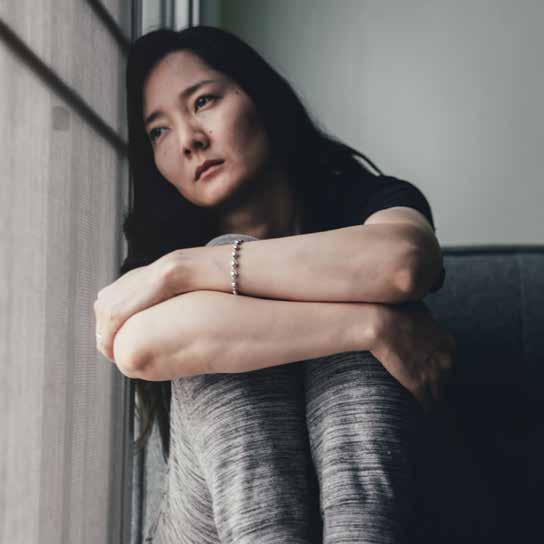
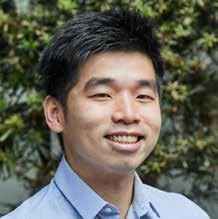
An Institute of Mental Health (IMH) study found that around 13 per cent of more than 1,000 participants surveyed between May 2020 and June 2021 reported symptoms of anxiety or depression, compared to one in 16 — or about 6 per cent — with depression in an earlier 2016 IMH study.
The COVID-19 pandemic apparently played a part in pushing up the incidence
Is what I am feeling just a low mood?

of depression, as it brought on a slew of uncertainties. COVID-19 protocols led to job instability or loss, coupled with new work and study arrangements that forced people to spend more time at home. While this may have been a happy situation for some people, the changes in interpersonal dynamics worsened the situation for those already facing difficult family relationships.
In treating patients with depressive symptoms, most are started off on psychotherapy and medication such as antidepressants to help modulate the neurochemicals that affect mood and emotions. Patients with severe depression may be offered more intensive treatments like electroconvulsive therapy (ECT) and transcranial magnetic stimulation (TMS).
Mental health specialists or psychiatrists may refer patients to psychologists and other allied healthcare professionals for talking therapy or psychotherapy and coaching in problem-solving and coping techniques. A medical social worker can help with accessing financial aid or family therapy, while an art
Where to seek help
therapist may use various forms of art to help patients communicate the issues troubling them. Art therapy can also be used as a way of easing tension and stress.
While studies have shown that a family history of depression increases the chance of getting the illness, the condition can affect anyone and be triggered by environmental factors. “There’s a wellknown connection between stress and depression. The death of someone close, a serious disease diagnosis or ongoing financial constraints can bring on stress and, in turn, bring on depression,” explained Dr Wong.
While undergoing treatment, patients are encouraged to adopt a healthier and active lifestyle, such as resuming exercise, going to their place of work and participating in hobbies and other social activities they used to enjoy. Strong social support from family, friends, colleagues and neighbours is also important for mental health as patients can turn to these relationships in times of need.
13 HealthWatch H e a lthierSG
Seeing a medical professional early can help prevent depression from reaching a critical stage.
Goh Bee Lian
“Clinical depression or major depressive disorder goes beyond normal everyday sadness,” says Dr Vincent Wong.
Beyond the Label SG https://www.ncss.gov.sg/our-initiatives/beyond-the-label HealthHub MindSG https://www.healthhub.sg/programmes/186/MindSG/Discover IMH 24-hour helpline: 6389 2222 Samaritans of Singapore (SOS) 24-hour hotline: 1-767 For resources and support on mental wellness, go to: OTOHP : V E R N O N WONG
ucational programme by Sengkang General Hospital (SKH) that aims to empower members of the public with health and medical-related knowledge.
Take charge of your health
Take charge of your health.
I
T ' S A S E A S Y A S 1 , 2 , 3 !
I T ' S A S E A S Y A S 1 , 2 , 3 !
mon Medical Conditions es offered:
of 11 sessions. Topics include ma, chronic cough, diabetes, dementia, skin allergies
The Community Health Academy (CHA) is a community educational programme by Sengkang General Hospital (SKH) that aims to empower members of the public with health and medical-related knowledge.
Scan to find out more!
The Community Health Academy (CHA) is a commun educational programme by Sengkang General Hospital (SKH) th aims to empower members of the public with health a medical-related knowledg
12 Aug - 25 Nov 2023
Modules offered:
Scan to find out more!
Common Medical Conditions Modules offered:
Scan to find out more!
Common Medical Conditions
en Do You Go to the ergency Department?
Total of 11 sessions. Topics include asthma, chronic cough, diabetes, dementia, skin allergies
6 sessions. Topics include acute hlessness, chest pain, stroke
Total of 11 sessions. Topics include asthma, chronic cough, diabetes, dementia, skin allergies
12 Aug - 25 Nov 2023
13 Jan - 2 Mar 2024
12 Aug - 25 Nov 2023
When Do You Go to the Emergency Department?
Total of 6 sessions. Topics include acute breathlessness, chest pain, stroke
ealth and Wellness
When Do You Go to the Emergency Department?
13 Jan - 2 Mar 2024
l of 8 sessions. Topics include ng and falls, cancer screening, nutrition, vaccination
1 2 3
Total of 6 sessions. Topics include acute breathlessness, chest pain, stroke
Health and Wellness
13 Jan - 2 Mar 2024
16 Mar - 11 May 2024
Total of 8 sessions Topics include ageing and falls, cancer screening, nutrition, vaccination
Health and Wellness
Sengkang General Hospital
16 Mar - 11 May 2024
be sent when registration is confirmed.
1 2 3
Sengkang General Hospital
Total of 8 sessions. Topics include ageing and falls, cancer screening, nutrition, vaccination
Details will be sent when registration is confirmed.
16 Mar - 11 May 2024
Sengkang General Hospital

Sign up for all 3 modules at $300 or pick any module to attend. Single session available at $20. Participants who successfully complete a module will be awarded a Certificate of Attendance.
Sign up for all 3 modules at $300 or pick any module to attend. Single session available at $20. Participants who successfully complete a module will be awarded a Certificate of Attendance.
To sign up or find out more:
To sign up or find out more:
Details will be sent when registration is confirmed.
Sign up for all 3 modules at $300 or module to attend. Single session ava $20. Participants who successfully c a module will be awarded a Certifica Attendance.
Tel: 6930 2994/6930 2996 (Mon-Fri, 9am-5pm)
Tel: 6930 2994/6930 2996 (Mon-Fri, 9am-5pm)
Email: education@skh.com.sg
Email: education@skh.com.sg
To sign up or find out more:
Tel: 6930 2994/6930 2996 (Mon-Fri, 9am-5pm)
Module 1 $200.00
Module 2 Module 3 $110.00 $150.00
Module
$110.00 $150.00
Module 1 $200.00 Module 2
3
Module
$200.00
Module
$110.00
1
Module 2
3
$150.00
Pacemaker? No problem
SGH goes to great lengths to keep patients safe and comfortable during an MRI scan to produce images of high quality.
by Goh Bee Lian
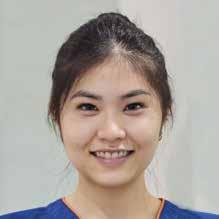
Tattoos may be a no-no, but most pacemakers are now okay.
Gone are the days when patients with pacemakers are not able to undergo magnetic resonance imaging (MRI) scans because of the dangers posed by the strong magnetic and radio waves the machines use.
New-generation MRI machines are usually made with pacemakers and implants in mind. Other features may also be built in, including the ability to play music or videos to help soothe anxious patients who may feel claustrophobic lying in the tunnel-like space within the MRI’s doughnut or bore.
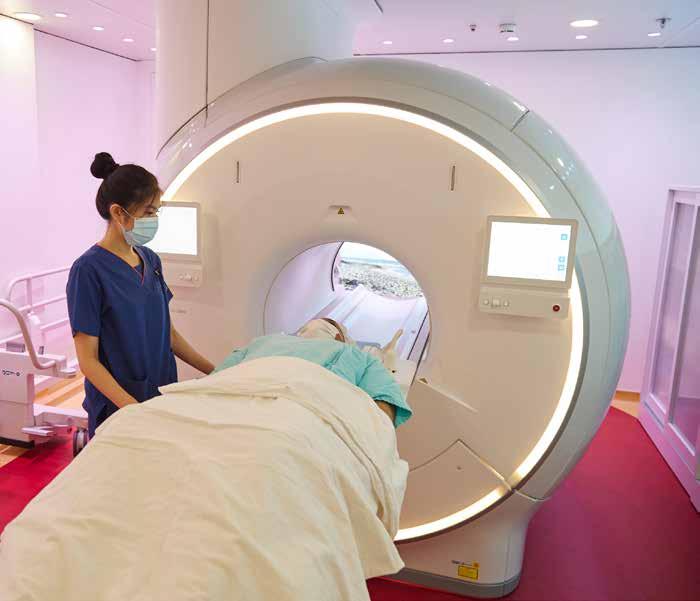
“With advances in MRI technology, it’s now possible to scan patients with implants, even those with certain pacemakers. We just need details about the implants, apply the appropriate workflow, and assign the right scanner for each job,” said Mr Zulhairy Zolkaffeli, Senior
Radiographer, Radiography Department, Singapore General Hospital (SGH).
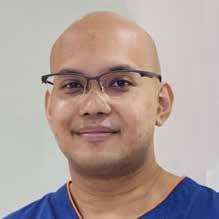
An MRI scanner is a large tube that contains powerful magnets to produce detailed images of the inside of the body. Almost any part of the body, including the brain and blood vessels, can be scanned. Patients fitted with a metal implant, such as a pacemaker, artificial joint or even an aneurysm clip, may not be able to undergo an MRI scan safely. Machines or implants that are not labelled MR Conditional will malfunction when exposed to the strong magnetic waves of an MRI machine. Even people sporting tattoos with metal fillings may feel the area heating up unbearably, while magnets in cochlear implants can move.
To address patient fears — a common issue — newer MRI machines have features to allay anxiety and claustrophobia. Patients with mild claustrophobia can have a mirror attached close to the face to reflect the view outside the bore instead of the tight
Radiography staff stay outside the MRI room during a scan, but are able to respond immediately when they see via CCTV that patients are in discomfort, says Ms Ong Zhen.
space within. SGH’s newest MRI machine can create a relaxing atmosphere and the illusion of more space and light. Scenes of a beach, for instance, can be played, while the scanning room can be lit in the patient’s preferred colour or turned off.
Ear plugs can be worn or soothing music played to drown out loud noises that the MRI machine makes during a scan. Patients can also listen to their own playlist, or watch films streamed from their mobile devices.
It does not help that patients have to stay very still inside the bore — measuring 55 to 70cm in diameter — for good quality images to be produced. Each scan lasts about 30 minutes and can be much longer if the patient needs several body parts scanned. Most patients are able to overcome their anxiety when radiographers offer them relaxation options and assurances. “We have CCTV in the room, so if we see the patient in discomfort — flailing his arms or pressing the call bell — we will stop the scan immediately and find out what’s wrong,” said Ms Ong Zhen, Senior Radiographer, Radiography Department, SGH.
Information like whether the patient has implants and anxiety issues is logged into his SGH online medical file by his doctor when an MRI scan is being ordered. The procedure and safety-related questions are highlighted again in the letter that is sent to him to inform him of his appointment. The patient can watch a YouTube video, Understanding MRI, to know what to expect during the procedure. A third check is made before his scan, with the same questions asked to ensure he meets all the safety criteria. If the patient is suspected of having forgotten to declare something metallic in the body, the radiographer can use a metal detector to check.
As MRI scans become increasingly common, patients sometimes request their doctor for one, as they view MRI to be safer than x-ray and CT (computed tomography) since no radiation is involved. Moreover, MRI is able to pick up some cancers that CTs cannot; it is also able to detect abnormalities in soft tissues better. An MRI may also be ordered together with a CT as a supplementary tool.
15 HealthWatch
The MRI machine above (the newest of nine that are used in SGH) has features like screening beach scenes or videos to calm anxious patients, says Mr Zulhairy Zolkaffeli. The patient can also ask for the light in the room to be in his favourite colour — in this case, lavender.
PHOTOS: VERNON WONG
Non-mechanical source of back pain
Ankylosing
by Sol E Solomon
Ankylosing spondylitis (AS) is a chronic condition that is commonly misdiagnosed as mechanical back pain. Its low prevalence means many people, including healthcare professionals, have a lack of familiarity and knowledge, which prevents AS patients from getting proper treatment early.
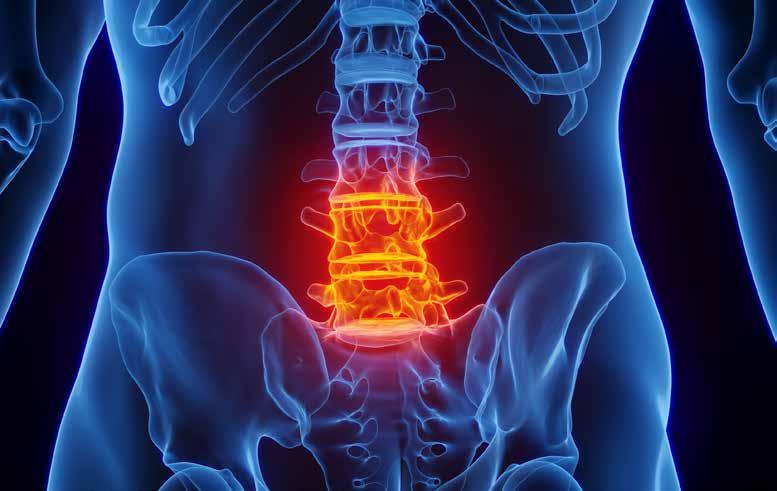
AS is an arthritic condition caused by the immune system attacking one’s own body. It begins with inflammation around the bones in the spine or joints. There is pain and stiffness in the back, neck and sometimes hips and heels. It can also produce eye problems, skin rashes and/or gastrointestinal symptoms in some cases. People afflicted with AS may also feel feverish and fatigued.
The pain usually starts in early adulthood, before age 40, comes on slowly and lasts for over three months. It feels better with movement and is worse after resting. The back may also become less flexible, making it harder to bend forward.
There is no single test for ankylosing spondylitis, said Dr Stanley Angkodjojo, Consultant, Rheumatology, Department of General Medicine, Sengkang General Hospital. “But your doctor or nurse should be able to tell if you have it by learning about your symptoms, doing an examination and using imaging tests like x-rays to look at your bones and joints.” A blood test can also be conducted to look for the presence of the HLA-B27 gene.
Knowledge is power
While there is no single test for ankylosing spondylitis, your doctor or nurse should be able to tell if you have it by learning about your symptoms, doing an examination and using imaging tests to look at your bones and joints, says Dr Stanley Angkodjojo.
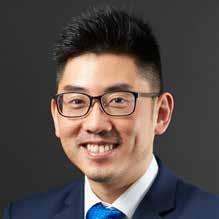
AS can make it hard to do simple things, such as getting dressed, getting up from a sitting position and looking from side to side. If the bones in your spine have fused together, you could be at risk of serious neck or back injury.
Though it can affect anyone, AS development has a genetic predisposition. The prevalence of AS parallels that of HLA-B27, a gene that increases the individual’s susceptibility of getting the condition. Onset of AS usually occurs in the teenage years, but it can begin in people up to around 50 years old. Globally, it is more common in males than females.
Awareness of the AS condition can lead to a more timely diagnosis for those suffering from backaches and joint pains, and better control of the condition.
According to a local study, the mean disease duration before the actual diagnosis of AS is about 10 years. Such delays mean AS patients suffer for years before getting appropriate help. It also affects their quality of life, with some even developing depression because they do not have the right tools and knowledge to monitor their symptoms.
“Knowledge can empower people to continue consulting with the right physicians until their condition is properly managed and disease progression can be delayed. Patients diagnosed with AS should speak to their doctor about the latest treatment options.
It is important for patients to partner with doctors to understand the disease in-depth and be informed about how the condition can be better managed to enable an enhanced quality of life,” said Dr Angkodjojo.
For those who are genetically predisposed, prevention may not be possible, but they can take steps to prevent complications and feel better while living with the condition. Correct treatment and lifestyle changes can help relieve symptoms, thus allowing them to do everyday activities and keep their condition from causing other problems.
Exercise is an important part of treating AS. Stretches and gentle exercises can strengthen the muscles and prevent some of the stiffness. It is especially important to work on posture because AS can cause the head to tilt forward in a hunchback posture.
Quitting smoking helps. Smokers with ankylosing spondylitis may be more likely to have breathing problems. Smoking can also worsen AS and makes the condition harder to control. Meanwhile, consuming plenty of calcium and vitamin D helps keep bones from getting weak.
AS patients may be prescribed non-steroidal anti-inflammatory drugs to relieve pain and stiffness. Biologics, which are genetically engineered proteins created from living organisms that mimic normal biological functions, are another option. This type of targeted therapy is aimed at specific proteins in the immune system that cause inflammation, and can reduce back pain and morning stiffness.
16 HealthWatch
spondylitis often causes pain and stiffness in the back and neck. Awareness is key to getting the right help quicker.
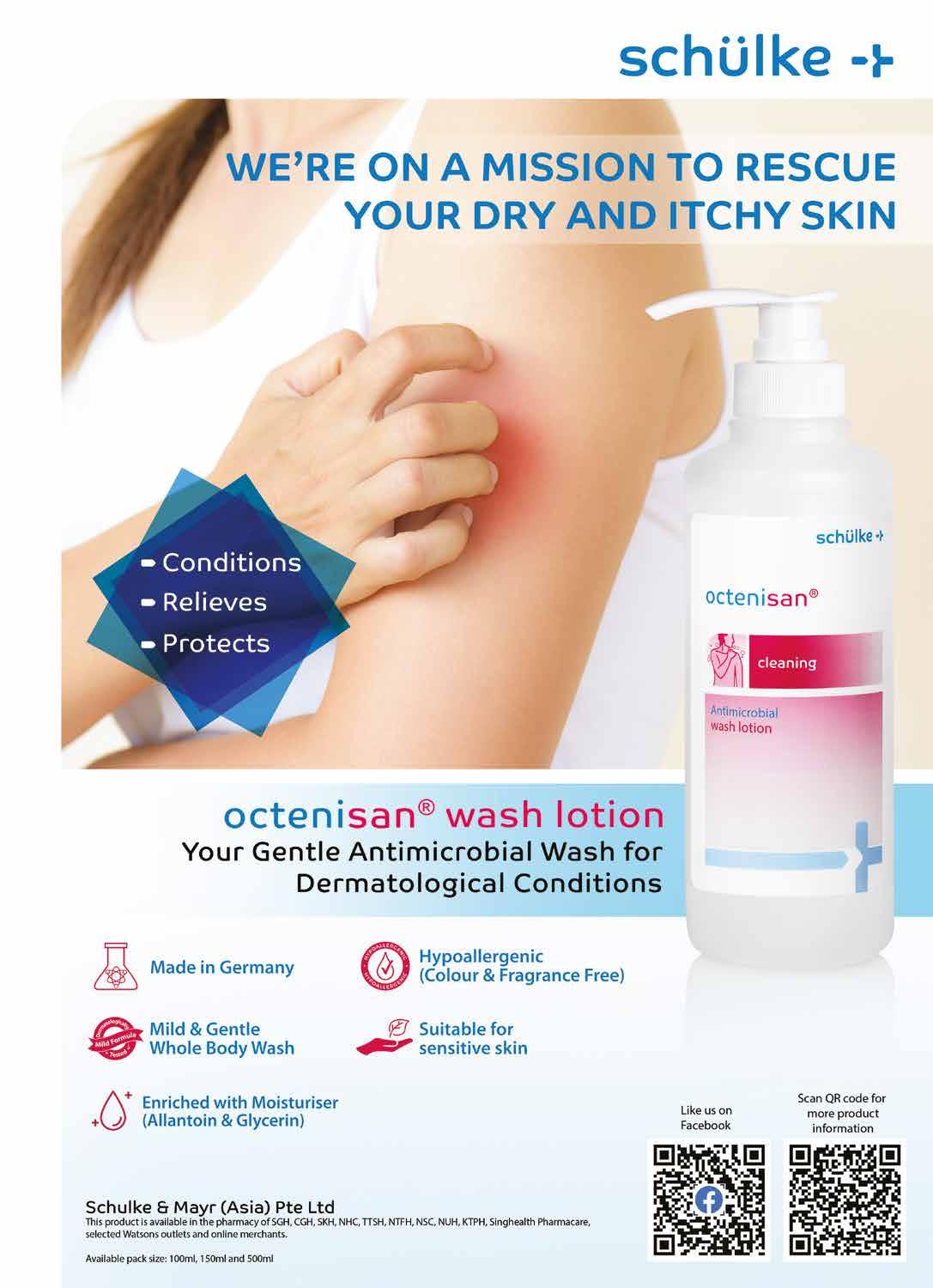
Bedtime procrastination
I work long hours. To relax before going to bed, I watch TV or play computer games. My late nights have made me tired the next day, but it’s difficult to break this habit. What can I do?

People who delay sleep even though they feel sleepy or tired do so because they prefer to do things like play games, watch their favourite dramas or chat with friends on their electronic devices. The pleasure they get from such activities is far greater than the fatigue they feel the next day, but they are unable to break the habit for various reasons. They are likely to have poor self-control and are habitual procrastinators in other aspects of their lives. They may also be suffering from stress at work or at home, and so try to exhaust themselves to avoid facing their problems or inner thoughts.
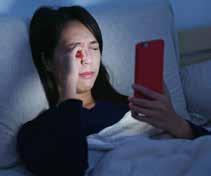
The adverse effects of this so-called revenge bedtime procrastination go beyond developing or exacerbating insomnia, circadian (the natural sleep-wake cycle) and other sleep disorders. Sleep deprivation can impair health and worsen medical conditions like hypertension and cardiovascular diseases, impaired immunity and certain types of cancer. Poor sleep can also adversely affect a person’s mood, cognition, and academic and work performance.
This phenomenon is becoming more common as activities that compete for our attention proliferate. There is an ever increasing amount of entertainment content, games, social media and e-commerce apps designed for instant gratification, leaving us craving for more, even when we are tired and should go to bed. After a long day, some people are just too tired to make logical decisions, such as prioritising sleep instead of staying up to catch the latest games or dramas.
To break this habit:
• Make sleep a priority
• Set a strict bedtime schedule
• Have an hour of device-free time before bedtime
• Seek help if insomnia or stress deter sleep
Dr Leow Leong Chai , Senior Consultant, Department of Respiratory and Critical Care Medicine, and Director, Sleep Disorders Unit, Singapore General Hospital
For more on getting a good night’s sleep go to SGH’s Perfectly Imperfect Health podcasts at https://open.spotify.com/episode/ 6Pp07ftavYVVVD3MmYZf5b or scan the QR code.


Suffering from Migraine?
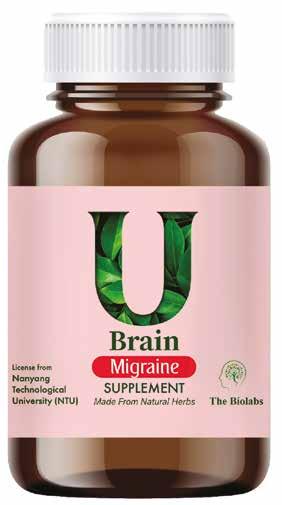
Severe throbbing pain on the side of head?
Extremely sensitive to light and sound?
Pins & needles sensation in arms or legs?
& A

Post-natal blues
Are there early tell-tale signs of postnatal depression (PND)?
What can I do to prevent it from worsening? How do I bring up this topic to my spouse without him brushing it off? When is it time for me to seek professional help?
Some common signs and symptoms of PND include:
• Low mood, anxiety and/or irritability persisting for two weeks or longer
• Inability to enjoy spending time with baby
• Sleep disturbance unrelated to baby’s needs
• Unexpected changes in appetite or weight
• Loss of energy
• Poor concentration or memory
• Excessive self-blame or guilt
• Feelings of hopelessness and negativity about the future
• Thoughts of harm to self or baby, or suicide
Many women experience some tearfulness and feelings of worry soon after delivery. However, if low mood and lack of positive emotions last beyond two weeks, it is likely that the mother has PND. It would be advisable to consult an obstetrician or family doctor, who may recommend a psychiatric referral; otherwise, seek psychiatric help directly.
Family members, including husbands, play a crucial role in helping mothers recover from PND. This is a time that is spent mostly at home, when life revolves primarily around the family. Family members are strongly encouraged to understand the illness and learn to provide the necessary reassurance and support.
 Dr Chua Tze-Ern , Head and Senior Consultant, Women’s Mental Wellness Service, Department of Psychological Medicine, KK Women’s and Children’s Hospital
Dr Chua Tze-Ern , Head and Senior Consultant, Women’s Mental Wellness Service, Department of Psychological Medicine, KK Women’s and Children’s Hospital
18 AskOurExpert
Q uestion
Scientific Breakthrough Made with 100% Natural Herbs Our Research Collaboration With Nanyang Technological University (NTU) Has Led To The Development Of Natural Herbal Supplements To Support Healthy Brain Functions. The Best Way To Stay Healthy Is By Staying Mentally Healthy Distributor: LINK Marketing Tel: 9857 9853 Email: cindysim1@gmail.com
nswer
that you can skip the hassle of scanning your NRIC at the security gantries by registering online ahead of your visit to SingHealth Tower and Outram Community Hospital? A new automatic facial recognition solution admits registered visitors.

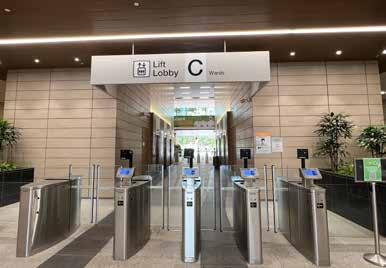


The Facial Recognition Automated Visitor Management Systems (FRAVMS) is being used in a healthcare setting in Singapore for the first time. Visitors can register and input key information, including a photograph. During their visit, their identities are then confirmed via facial recognition. The system also detects body temperature to ensure visitors are physically well to enter the premises. The entire process is also contactless, making it ideal for infection control.
The FRAVMS facilitates a smoother and more efficient visitor registration process as there is no need to queue and register at hospitals.
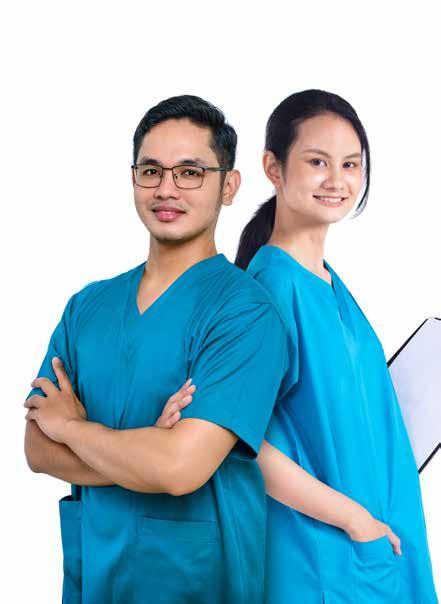

that the food court near Singapore General Hospital (SGH) Block 5 will reopen in the coming months after undergoing renovations that began in May?
Koufu, which will operate the food court, is refreshing the outlet’s essential facilities and equipment for customers’ safety, hygiene and comfort.


In the meantime, visitors to SGH can patronise other food establishments offering a variety of food options within SGH or at other SingHealth institutions nearby. To see the nearest outlets and their operating hours, refer to the map.
FOODCOURT


19 DidYouKnow
UNDER RENOVATION SECONDHOSPITALAVENUETHIRDHOSPITALAVENUE FIRST HOSPITAL AVENUE HOSPITALCRESCENT HOSPITALBOULEVARD HOSPITALDRIVE COLLEGEROAD MACALISTERROAD OUTRAM ROAD NEIL ROAD EUTONGSENGSTREET KAMPONGBAHRUROAD TOCTE TOAYE NATIONAL CANCER CENTRE SINGAPORE (NCCS) SINGAPORE GENERAL HOSPITAL (SGH) OUTRAM PARK MRT EAST-WEST LINE (EWL) THOMSON-EAST COAST LINE TEL) OUTRAM PARK MRT NORTH-EAST LINE (NEL) MINISTRY OF HEALTH (MOH) DUKE-NUS MEDICAL SCHOOL HOUSEMEN’S CANTEEN SINGAPORE NATIONAL EYE CENTRE (SNEC) ALUMNI ASSOCIATION ACADEMIA SGH MUSEUM BLK 9 BLK 7 BLK 6 BLK 5 BLK 3 BLK 2 BLK 4 A&E NATIONALHEART CENTRESINGAPORE (NHCS) OUTRAMCOMMUNITYSINGHEALHOSPITAL(OCH) THTOWER HEALTH SCIENCES AUTHORITY (HSA) HEALTH PROMOTION BOARD (HPB) NATIONAL DENTAL CENTRE SINGAPORE (NDCS) BOWYER BLOCK 08 07 03 02 01 09 05 10 04 06 DIABETES & METABOLISM CENTRE (DMC) 09 THE FOOD PLATELETS 08 WHOLESOME 07 ORCHID THAI (HALAL) 06 HOUSEMEN'S CANTEEN 10 GURIRU 05 LAI MAKAN 02 04 O’COFFEE CLUB 03 KAFFE & TOAST (HALAL) SG HAWKERS KOUFU STARBUCKS FAIRPRICE XPRESS KOI 01 REMPAH BY CHILLI PADI (HALAL) 7-ELEVEN MR. BEAN (HALAL) TRIPLETS (HALAL) THE COFFEE BEAN & TEA LEAF (HALAL) KAFFE & TOAST (HALAL) POLAR CAFÉ (HALAL) FOODCOURT UNDER RENOVATION SECONDHOSPITALAVENUETHIRDHOSPITALAVENUE FIRST HOSPITAL AVENUE HOSPITALCRESCENT HOSPITALBOULEVARD HOSPITALDRIVE COLLEGEROAD MACALISTERROAD OUTRAM ROAD NEIL ROAD EUTONGSENGSTREET KAMPONGBAHRUROAD TOCTE TOAYE NATIONAL CANCER CENTRE SINGAPORE (NCCS) SINGAPORE GENERAL HOSPITAL (SGH) OUTRAM PARK MRT EAST-WEST LINE (EWL) THOMSON-EAST COAST LINE TEL) OUTRAM PARK MRT NORTH-EAST LINE (NEL) MINISTRY OF HEALTH (MOH) DUKE-NUS MEDICAL SCHOOL HOUSEMEN’S CANTEEN SINGAPORE NATIONAL EYE CENTRE (SNEC ALUMNI ASSOCIATION ACADEMIA SGH MUSEUM BLK 9 BLK 7 BLK 6 BLK 5 BLK 3 BLK 2 BLK 4 A&E NATIONALHEART CENTRESINGAPORE (NHCS) OUTRAMCOMMUNITYSINGHEALHOSPITAL(OCH) THTOWER HEALTH SCIENCES AUTHORITY (HSA HEALTH PROMOTION BOARD (HPB) NATIONAL DENTAL CENTRE SINGAPORE (NDCS) BOWYER BLOCK 08 07 03 02 01 09 05 10 04 06 DIABETES & METABOLISM CENTRE (DMC 09 THE FOOD PLATELETS 08 WHOLESOME 07 ORCHID THAI (HALAL) 06 HOUSEMEN'S CANTEEN 10 GURIRU 05 LAI MAKAN 02 04 O’COFFEE CLUB 03 KAFFE & TOAST (HALAL) SG HAWKERS KOUFU STARBUCKS FAIRPRICE XPRESS KOI 01 REMPAH BY CHILLI PADI (HALAL) 7-ELEVEN MR. BEAN (HALAL) TRIPLETS (HALAL) THE COFFEE BEAN & TEA LEAF (HALAL) KAFFE & TOAST (HALAL) POLAR CAFÉ (HALAL) FOODCOURT UNDER RENOVATION SECONDHOSPITALAVENUETHIRDHOSPITALAVENUE FIRST HOSPITAL AVENUE HOSPITALCRESCENT HOSPITALBOULEVARD HOSPITALDRIVE COLLEGEROAD MACALISTERROAD OUTRAM ROAD NEIL ROAD EUTONGSENGSTREET KAMPONGBAHRUROAD TOCTE TOAYE NATIONAL CANCER CENTRE SINGAPORE (NCCS) SINGAPORE GENERAL HOSPITAL (SGH) OUTRAM PARK MRT EAST-WEST LINE (EWL) THOMSON-EAST COAST LINE (TEL) OUTRAM PARK MRT NORTH-EAST LINE (NEL) MINISTRY OF HEALTH (MOH) DUKE-NUS MEDICAL SCHOOL HOUSEMEN’S CANTEEN SINGAPORE NATIONAL EYE CENTRE (SNEC) ALUMNI ASSOCIATION ACADEMIA SGH MUSEUM BLK 9 BLK 7 BLK 6 BLK 5 BLK 3 BLK 2 BLK 4 A&E NATIONALHEART CENTRESINGAPORE (NHCS) OUTRAMCOMMUNITYSINGHEALHOSPITAL(OCH) THTOWER HEALTH SCIENCES AUTHORITY (HSA) HEALTH PROMOTION BOARD (HPB) NATIONAL DENTAL CENTRE SINGAPORE (NDCS) BOWYER BLOCK 08 07 03 02 01 09 05 10 04 06 DIABETES & METABOLISM CENTRE (DMC) 09 THE FOOD PLATELETS 08 WHOLESOME 07 ORCHID THAI (HALAL) 06 HOUSEMEN'S CANTEEN 10 GURIRU 05 LAI MAKAN 02 04 O’COFFEE CLUB 03 KAFFE & TOAST (HALAL) SG HAWKERS KOUFU STARBUCKS FAIRPRICE XPRESS KO 01 REMPAH BY CHILLI PADI (HALAL) 7-ELEVEN MR. BEAN (HALAL) TRIPLETS (HALAL) THE COFFEE BEAN & TEA LEAF (HALAL) KAFFE & TOAST (HALAL) POLAR CAFÉ (HALAL) FOODCOURT UNDER RENOVATION SECONDHOSPITALAVENUETHIRDHOSPITALAVENUE FIRST HOSPITAL AVENUE HOSPITALCRESCENT HOSPITALBOULEVARD HOSPITALDRIVE COLLEGEROAD MACALISTERROAD OUTRAM ROAD NEIL ROAD EUTONGSENGSTREET KAMPONGBAHRUROAD TOCTE TOAYE NATIONAL CANCER CENTRE SINGAPORE (NCCS) SINGAPORE GENERAL HOSPITAL (SGH) OUTRAM PARK MRT EAST-WEST LINE (EWL) THOMSON-EAST COAST LINE (TEL) OUTRAM PARK MRT NORTH-EAST LINE (NEL) MINISTRY OF HEALTH (MOH) DUKE-NUS MEDICAL SCHOOL HOUSEMEN’S CANTEEN SINGAPORE NATIONAL EYE CENTRE (SNEC) ALUMNI ASSOCIATION ACADEMIA SGH MUSEUM BLK 9 BLK 7 BLK 6 BLK 5 BLK 3 BLK 2 BLK 4 A&E NATIONALHEART CENTRESINGAPORE (NHCS) OUTRAMCOMMUNITYSINGHEALHOSPITAL(OCH) THTOWER HEALTH SCIENCES AUTHORITY (HSA) HEALTH PROMOTION BOARD (HPB) NATIONAL DENTAL CENTRE SINGAPORE (NDCS) BOWYER BLOCK 08 07 03 02 01 09 05 10 04 06 DIABETES & METABOLISM CENTRE (DMC) 09 THE FOOD PLATELETS 08 WHOLESOME 07 ORCHID THAI (HALAL) 06 HOUSEMEN'S CANTEEN 10 GURIRU 05 LAI MAKAN 02 04 O’COFFEE CLUB 03 KAFFE & TOAST (HALAL) SG HAWKERS KOUFU STARBUCKS FAIRPRICE XPRESS KO 01 REMPAH BY CHILLI PADI (HALAL) 7-ELEVEN MR. BEAN (HALAL) TRIPLETS (HALAL) THE COFFEE BEAN & TEA LEAF (HALAL) KAFFE & TOAST (HALAL) POLAR CAFÉ (HALAL) FOODCOURT UNDER RENOVATION SECONDHOSPITALAVENUETHIRDHOSPITALAVENUE FIRST HOSPITAL AVENUE HOSPTALCRESCENT HOSPITALBOULEVARD HOSPTALDRIVE COLLEGEROAD MACALISTERROAD OUTRAM ROAD EIL ROAD EUTONGSENGSTREET KAMPONGBAHRUROAD TOCTE TOAYE NATIONAL CANCER CENTRE SINGAPORE (NCCS) SINGAPORE GENERAL HOSPITAL (SGH) OUTRAM P EAST-WEST LINE (EWL) AST LINE TEL) OUTRAM PARK MRT NORTH-EAST LINE (NEL) MINISTRY OF HEALTH (MOH) DUKE-NUS MEDICAL SCHOOL HOUSEMEN’ CANTEEN SINGAPORE NATIONAL EYE CENTRE (SNEC ALUMNI ASSOCIATION ACADEMIA SGH MUSEUM BLK 9 BLK 7 BLK 6 BLK 5 BLK BLK 2 BLK 4 A&E NATIONALHEART CENTRESINGAPORE (NHCS) OUTRAMCOMMUNITYSINGHEALHOSPITAL(OCH) THTOWER HEALTH SCIENCES UTHORITY (HSA) HEALTH PROMOTION BOARD (HPB) NATIONAL DENTAL CENTRE SINGAPORE (NDCS) BOWYER BLOCK 08 07 03 02 01 09 05 10 04 06 DIABETES & METABOLISM CENTRE (DMC) 09 THE FOOD PLATELETS 08 WHOLESOME 07 ORCHID THAI (HALAL) 06 HOUSEMEN'S CANTEEN 10 GURIRU 05 LAI MAKAN 02 04 O’COFFEE CLUB 03 KAFFE & TOAST (HALAL) SG HAWKERS KOUFU STARBUCKS FAIRPRICE XPRESS KO 01 REMPAH BY CHILLI PADI (HALAL) 7-ELEVEN MR. BEAN (HALAL) TRIPLETS (HALAL) THE COFFEE BEAN & TEA LEAF (HALAL) KAFFE & TOAST (HALAL) POLAR CAFÉ (HALAL)
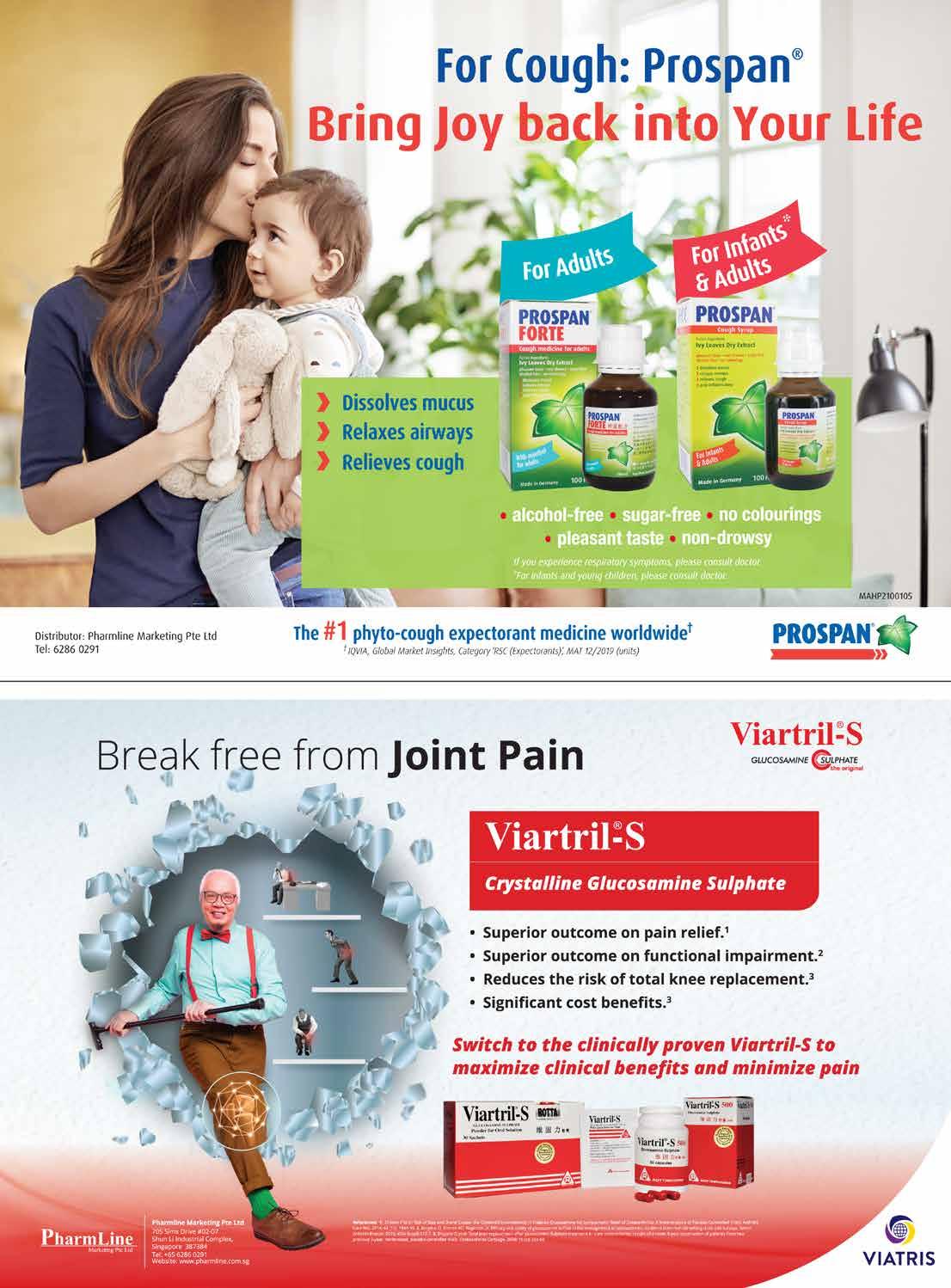







 by Chua Kim Beng
by Chua Kim Beng


























 by Goh Bee Lian
by Goh Bee Lian































 Dr Chua Tze-Ern , Head and Senior Consultant, Women’s Mental Wellness Service, Department of Psychological Medicine, KK Women’s and Children’s Hospital
Dr Chua Tze-Ern , Head and Senior Consultant, Women’s Mental Wellness Service, Department of Psychological Medicine, KK Women’s and Children’s Hospital





















